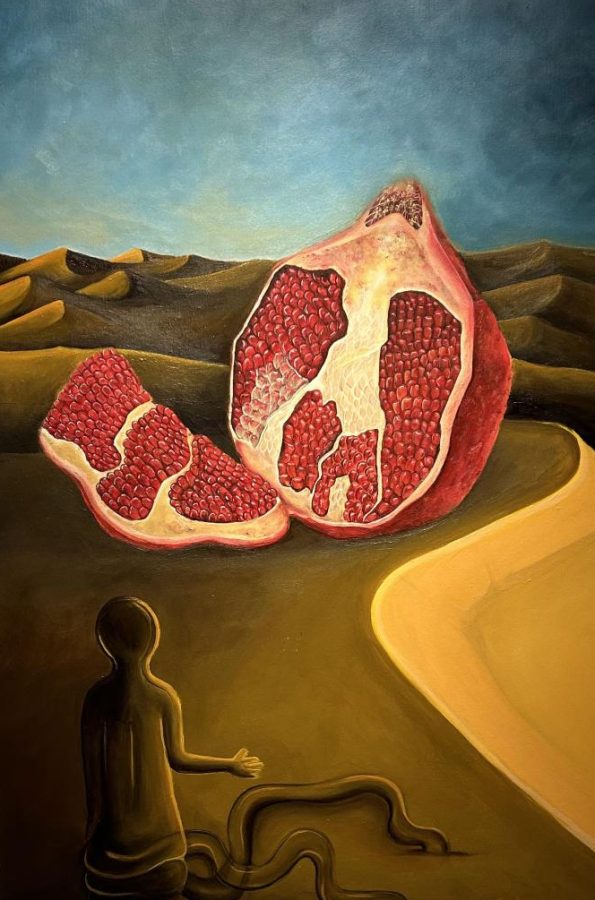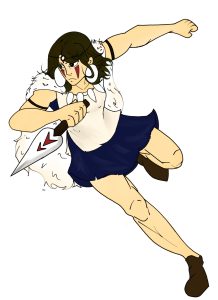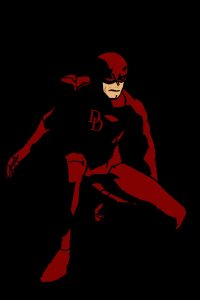39th Annual Juried Exhibition features UTSA’s student artists
April 4, 2023
Every year, UTSA students have the opportunity to have their art displayed at the Main Gallery as a part of the Annual Juried Exhibition.
“[Juried shows] give students an opportunity to see how their work as artists is entering into professional conversations,” Dr. Scott Sherer, an art history professor who serves as the director of galleries at UTSA, said. “It’s not a question of judgment, it’s a question of entering dialogue and I think it’s important to enter dialogues. These kinds of exhibits [are] really about creating those opportunities, and I think that’s an important thing to think about. It’s not just the final work in the gallery itself — it’s the whole process of doing it.”
“In the space, you [also] have a lot of viewpoints and I think that’s a great thing, too,” Sherer added. “We really get a wonderful snapshot of what [UTSA students are making], what are they thinking about [and] what are they showing.”
Once applications are open, interested undergraduate and graduate students can submit up to five pieces for consideration. This year, close to 300 works were submitted by a total of 80 students.
Once the submissions are over, a juror then goes through all the submissions to select the pieces that will be on display at the gallery. The juror’s decision is unbiased — they view the artwork without having any knowledge of the artist.
This year, artist and retired professor Delilah Montoya served as the exhibition’s juror.
“[Selecting pieces] was really difficult just because there was so much good work,” Montoya said.
One of the reasons Montoya decided to juror for this year’s exhibition was because of the desire to support students.
“I like to be [in] situation[s] where I can support other students [and their works], and I felt like this would be a very good way of doing that,” Montoya said.
Art pieces selected this year ranged from traditional paintings and self-portraits to life-size sculptures and new-media works. Out of the pieces selected, a Best of Show Prize and first, second and third place prizes were awarded.
“Mi Chaparrita de Oro” by Claribel Olivas
This year, Master of Fine Arts student Claribel Olivas’ piece was awarded Best of Show.
Like many of Olivas’s work, the piece is created using materials other than paper. It is made entirely from scraps of previous projects and is titled after an affectionate name given by Olivas’ grandfather.
“My grandfather is one of the most positive influences in my life, so every time I look at this work, I am reminded of all those I love,” Olivas said.
“Shaman Staff” by Kelsey Wallace
One of the other pieces featured in this exhibition was by Kelsey Wallace, a senior Bachelor of Fine Arts student. Wallace’s work primarily focuses on nature and paganism.
Out of the five pieces submitted, one of Wallace’s sculpture pieces was selected for the exhibition.
Titled “Shaman Staff,” the piece was created from a tree branch collected while working at a house in Fair Oaks Ranch. The branch belonged to a dead oak tree that had always caught Wallace’s eye. One day, while cleaning out the trash, Wallace noticed a branch on the tree and took it home.
“I saw a branch on that tree, and I just had this overwhelming feeling [that I needed that branch]. So, I took the branch, put it in my car and brought it home. I was looking at it, and I just kind of started putting stuff together. I wasn’t really thinking about it; I was just going off of my feeling [and anything else the branch needed],” Wallace explained.
“It’s Time to Mourn” by Angelica Romo
Another sculpture featured in the exhibition was by Master of Fine Arts student Angelica Romo, a first-generation Mexican American printmaker from Chicago based out of San Antonio.
Romo’s life-size sculpture of a faceless woman with black marks on her body “speaks on the femicide and missing female-identifying people occurring every day, not just in the U.S. or Mexico, but across the Americas.”
The piece is made of tamale-corn husks — an intentional choice that contributes to the meaning of the work.
“In Indigenous cultures, a faceless cornhusk doll is made to represent women who have gone missing,” Romo said. “Corn is also seen as sacred, and the husks symbolize protection. The black marks on the body are a representation of acts of violence corrupting the original form until the old, original version is gone.”
“I chose this piece because it is important to bring awareness to those who are missing, murdered, or dealing with these acts of violence and demand change,” Romo added.
Through the piece, Romo also wanted to bring attention to the Supreme Court’s efforts to overturn the Indian Child Welfare Act of 1978.
“The hearing is in two months, and I believe that if overturned it is Native erasure,” Romo said.
“Ni Una Mas, Ni Una Menos” by Melany Guerra
Along with sculptures, the exhibition also featured 2D work.
One of these pieces was by Melany Guerra, a senior Bachelor of Fine Arts student with a minor in archeology and art history and criticism.
Guerra’s piece is a “homage to the feminism movement in Mexico.”
“Every single day, 10 women in Mexico are being assaulted, raped or killed and it’s usually by [someone they know],” Guerra said.
Guerra further explained that the piece is a reference to Women’s Day protests in Mexico, during which hundreds and thousands of women dressed in purple gather and chant the names of “women who are no longer with us.”
Titled “Ni Una Mas, Mi Una Menos,” the piece features three different paintings. The first is an empty room with a chair in the foreground and sunlight streaming through a window.
“I wanted to create the emptiness of a room where a woman is no longer with us,” Guerra said.
The second is a painting of the slogan “Ni una más ni una menos” which means “not one more not one less.”
The third painting of the piece is that of an agave plant which is commonly found in Mexico. Guerra wrote the names of all the victims that have been killed as a result of “toxic masculinity” in this painting.
“That’s what I usually focus on — social justice, misrepresentation and focusing my art [on] Indigenous people and stuff like that from Mexico,” Guerra said.
“The Visitor” by Sarah Coleman
Another painting selected for the show was that of senior Bachelor of Fine Arts student Sarah Coleman.
Coleman’s work often deals with the exploration of human consciousness.
The selected painting depicts a giant pomegranate in a desert with a translucent figure in the foreground.
Coleman drew inspiration from the depictions of desert settings as a “place of trial and revelation” in literature, religious texts and popular media.
The desert represents being in a “desolate palace [with] little signs of life or excitement.” The bright pomegranate in the middle of the desert represents stumbling upon a sign of life in the form of succulent fruit in a dry place. The translucent figure in the foreground stumbling upon this scene represents feeling “out of yourself” and quiet from within.
“I wanted it to be a piece you look at and explore what that relationship [is] between all three — the desert, the translucent person and the fruit,” Coleman said.
“Cosmic Abundance” by Cameron Woods
While a lot of the students participating in the exhibition were art majors, that was not the case for junior psychology major Cameron Woods.
“While I definitely had so many other passions and so many other interests, I was like, I will always bring art to it,” Woods said.
Woods, who participated in the exhibition for a second time, first learned about it while trying to find ways to be featured in the Main Gallery.
“My [motivation] was [the fact that] I really want to establish my name as an artist,” Woods said.
This year, Woods’ piece is a self-portrait made with color and ink created during the pandemic.
“‘Cosmic Abundance’ is about the celebration of identity,” Woods said.
“During the pandemic, that’s [when] I started getting really comfortable with the idea that I am Black. I was also getting comfortable with my identity as an artist and also as a queer person,” Woods added. “And with those, there’s this intersection where my expression outwards and inwards is very near and dear to my heart. And I never like to be silenced, or I don’t like to be reduced when someone says [I should] tone it down. Sometimes I felt like some people reduced how they perceived me, so I wanted to talk about that in my piece.”
“As a self-portrait, it originally started with my Black identity,” Woods went on to explain.
The piece draws on the feeling of needing to “switch” and turn off that identity around what Woods described as “people who don’t look like me.” This feeling is depicted through a mask and a tree incorporated in the painting to give a nod to the idea of filtering.
“The moment I started putting colors down and dots and lines and just a bunch of patterns, it kind of reminded me of a rainbow. Sometimes I just feel like a bunch of colors that just wanted to just always show all at the same time or just tapestry in a way with so many unique details, and you can’t really reduce it all, but you just got to take it for what it is in its whole. I definitely wanted to steer towards that.”
“I Can’t Believe This Could Be The End” by Bruce Wylie Jr.
Bruce Wylie Jr., a second-year Master of Fine Arts student, is also participating in the exhibition for the second time.
This year, Wylie’s piece is an acrylic transfer on panel. It depicts a person defacing a sign that says, “No Dogs. No Negroes. No Mexicans.” by writing “Te lo Sico” over the sign, which means “shut your mouth.”
“This was just really a comment on the attempts by certain political parties in America to erase histories of minorities and how it affects us for generations,” Wylie said.
The title of the piece comes from the song “Don’t Speak” by the band No Doubt.
“I made that connection because the gentleman who is defacing [the sign in the piece is] conflicting that sign,” Wylie said. “That’s how I view people that fight against the [removal] of tenure. SB3 that’s going through [the Texas legislature] right now — a lot of it is targeting professors that teach [critical race theory] and if it does pass, it will remove a lot of the most important educators in the state of Texas [from the state]. So, it is something serious, it is something to talk about and something that needs to be brought up.”
“If you don’t know [history], you’re doomed to repeat it,” Wylie added. “That’s what my piece was about.”
The 39th Juried Exhibition is on display at UTSA’s Main Gallery until April 7. Gallery hours are from 9 a.m. to 5 p.m., Thursday through Saturday.










